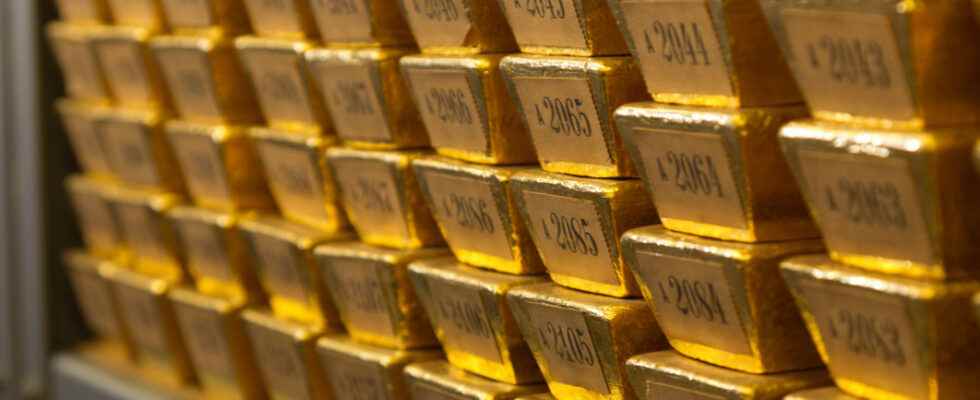(BFM Bourse) – Expressed in dollars, the price of the barbaric relic has fallen by 4% since the start of the year, a fall certainly less than the stock markets but which undermines the status of a safe haven for the precious metal. The strength of the dollar and the rise in interest rates are behind this sluggish performance.
The precious metal hardly shines with its performance. Supposed to constitute a shield against the tumults of the market, the gold knows a stock market evolution without relief.
Expressed in dollars, the ounce lost 4.3%
since the start of the year, which is admittedly a lower decline than that of the major stock market indices. Over the same period, the S&P 500 on Wall Street dropped 15% and our national CAC 40 fell by 6%.
Read also
“Gold is not considered a bulwark against inflation, other products are more effective, such as certain raw materials (copper, nickel, cobalt), including those that may be linked to the energy transition or even real estate. “said Christopher Dembik, director of macroeconomic research at Saxo Bank.
A “barbaric relic” without yield
The course of the precious metal has, in fact, suffered jolts. “Gold prices first experienced a positive first quarter, during which they almost equaled their summer 2020 record in reaction to the invasion of Ukraine”, underlines Arnaud du Plessis, portfolio manager thematic equities specialist in gold and natural resources at CPR Asset Management. [l’once, NDLR] “They then underwent a major consolidation movement until the end of the summer, from $2,070
to around 1,615 dollars, in connection with the strong monetary tightening of the Fed which led to a rise in real US interest rates. Since the end of September, the market has stabilized and even started to rebound from the beginning of November,” he adds.
“More than inflation, it is the evolution of real interest rates that has influenced the course of gold this year. However, the significant rise in US real rates that has been observed this year, coupled with a the strong strength of the dollar (to which, historically, gold is inversely correlated), could have weighed much more on prices. Gold therefore showed a fairly strong resistance”, also qualifies the manager. The specialist points out that, denominated in euros, and no longer in dollars, gold is moving into positive territory by around 5%.
Rising interest rates indeed penalize the precious metal – which John Maynard Keynes dubbed the “barbaric relic” – because gold does not produce income, such as dividends or coupons. The increase in rates thus undermines the arbitration which consists of investing in gold rather than investing cash and therefore receiving interest.
“Investors are wondering if gold is still as interesting in a portfolio since gold has no return,” explained Benjamin Louvet, commodity manager at OFI AM, at the beginning of the month. on BFM Business.
The rise in the dollar weighs on gold because it makes the raw material more expensive for buyers whose operations are carried out in another currency. An effect that also plays on other assets, such as oil.
Stagflation
Looking ahead, UBS expects gold to come under further pressure in the first half of 2023, before a “modest” rebound by the end of next year.
But other financial intermediaries do not fully share this opinion. The financial services company Atlantic Financial Group estimates that gold, in 2023, “will appreciate, after having suffered from the positive remuneration of cash and the strength of the dollar”.
Arnaud du Plessis emphasizes for his part that the market takes note of several elements. “First, the upcoming halt to the cycle of key rate hikes by the Federal Reserve, the market estimating between 100 to 125 basis points (1 to 1.25 percentage points, editor’s note) the remaining rise to reach the rate pivot,” he says.
“Then, the market anticipates a deterioration in the economic situation in 2023, characterized on the one hand by a risk of economic recession and on the other hand by an inflation rate which, if it stops increasing, will undoubtedly continue. above the 2% targeted by central banks”, continues the manager.
“Such a ‘stagflation’ environment would be particularly conducive to a rebound in gold prices. Finally, central banks bought gold at a very strong pace during the third quarter, which is a supporting factor extra,” he said.
Record central bank purchases
In the third quarter central banks acquired almost 400 tonnes of gold, gold.org/news-and-events/press-releases/world-gold-council-report-climate-change-adaptation-and-resilience”> According to the World Gold Council According to the Comptoir national de l’or, over nine months these purchases totaled 673 tons.
“The previous quarterly record was 240 tons. And over nine months we have already beaten the annual record which dated from 2018 for the modern era. In 1967 we had 1,400 tons of gold over one year but at that time the Bretton Woods agreements were still in place and the currencies were anchored to the price of gold”, explains Benjamin Louvet.
Why are monetary institutions so interested in this precious metal? The main explanation “lies in the desire on the part of these countries to free themselves from the dollar and the fact that it can be used as an economic weapon”, indicates Le Comptoir national de l’or.
“In this regard, the sanctions against Russia and the seizure of dollar assets from the Russian central bank have accelerated the desire to diversify their reserves in many emerging countries. And gold, which is both universal and controlled per person, is the natural candidate,” he concludes.
Variations stopped at Friday at the beginning of the afternoon. Gold’s move is based on the December contractJulien Marion – ©2022 BFM Bourse
Source link -84
